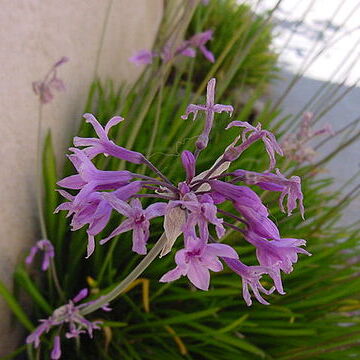Plant to 70 cm high.. Rootstock a corm with rhizomatous base, ovoid, 1.5–2.7 cm long, 1–1.5 cm in diameter.. Leaves 8–10, linear, 17–50 cm long, 0.35–0.7 cm wide, apex obtuse, base sheathing.. Scape 39–70 cm long.. Umbel 11-flowered, opening in succession, erect or patent, bright purple; pedicels 10–20 mm long.. Perianth tube cylindrical, 8–10 mm long, lobes 6–7 mm long, 1.5–2.8 mm wide, elliptic, apex acute with slightly inrolled margin, one distinct mid-vein sometimes giving the lobe a keeled appearance.. Corona of 3 distinct lobes, 2.5–3 mm long, 1–1.5 mm wide, oblong, apex retuse.. Stamens included in perianth tube, upper series 2–2.5 mm below mouth, lower series ± 6 mm from base; anthers 1 mm long.. Ovary oblong to obovoid, 2.5 mm long, 1.5 mm in diameter; ovules numerous.. Style 1 mm long, 0.4 mm in diameter.. Stigma capitate, small.. Capsule and seeds not seen.
More
An onion family plant. It is a clump forming plant. It can remain evergreen or die down during the year. It grows 30-60 cm high. It spreads 30 cm wide. The leaves are narrow and 25 cm long. They are grey-green. They have a garlic scent. The flowers are small and funnel shaped. They are pale purple. The stalk is 60 cm tall. They have a sweet scent.
It is a Mediterranean climate plant. It occurs naturally in South Africa. It needs moderate moisture but it can be dry while dormant. It needs fertile, well drained soil. It can grow in full sun or light shade. It is hardy to frost. It is drought resistant. It suits hardiness zones 8-10. Melbourne Botanical Gardens.
More
Forest margins and stream banks. Found at elevations from sea level to 1,220 metres.
Forest margins and stream banks.

